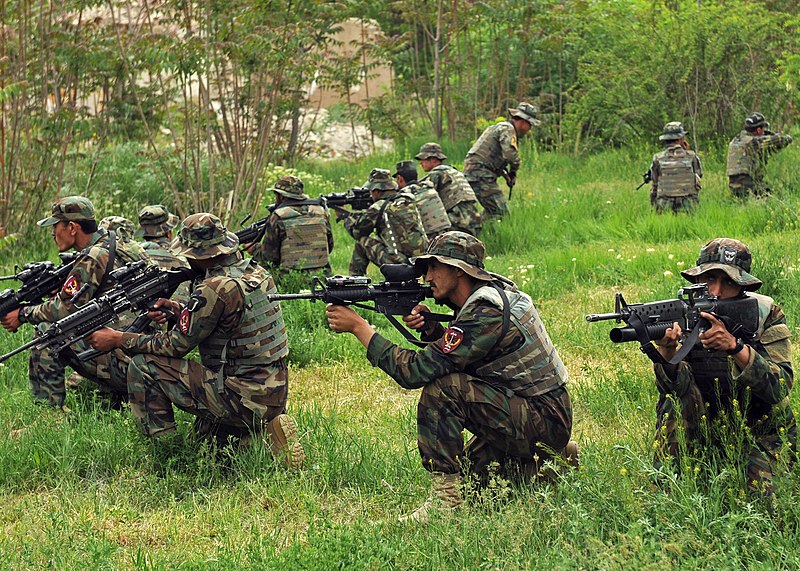The Joe Biden administration has blamed the Afghanistan troops’ drawdown fiasco entirely on the shoulders of his predecessor Donald Trump. It has made critical comments about his leadership and how he gave a free run to the Taliban to run over the civilian government in Kabul in August 2021.
In a 12-page after-action review that outlined the key decisions and challenges surrounding the US withdrawal from Afghanistan released by the White House on April 6, the Biden administration accused Trump of decisions and actions that weren’t in the best interests of the 2,500-odd soldiers deployed in the war-torn Asian nation in 2021.
The review, which provides a peek at what went into the chaotic drawdown of troops and is seen as an attempt to attack Trump politically, concluded that any problems in the military withdrawal from Afghanistan were the fault of the predecessor’s administration.
The American forces withdrew from Afghanistan in August 2021 in such a hurry, and the US military earned ignominy that parallels only its Vietnam debacle between 1954 and 1973. Consequently, the US forces had to abandon and leave behind sophisticated military equipment in Afghanistan, estimated to be worth US $7 billion.
Biden Regime’s Hands Tied By Trump’s Actions
“President Biden had committed to ending the war in Afghanistan, but when he came into office, he was confronted with difficult realities left to him by the Trump Administration. President Biden’s choices for executing a withdrawal from Afghanistan were severely constrained by conditions created by his predecessor,” the document said.
When President Trump took office, there were 10,000 troops in Afghanistan. Trump “emboldened” the Taliban by meeting with them at Camp David and agreeing to pull troops out.
“As part of the deal, President Trump also pressured the Afghan government to release 5,000 Taliban fighters from prison, including senior war commanders, without securing the release of the only American hostage known to be held by the Taliban,” it read.

This had put Biden and his administration in an impossible position when it took office in January 2021, racing against time to complete the withdrawal so that the small number of deployed soldiers do not come under a Taliban attack.
“During the transition from the Trump Administration to the Biden Administration, the outgoing administration provided no plans for how to conduct the final withdrawal or to evacuate Americans and Afghan allies. Indeed, there were no such plans in place when President Biden came into office, even with the agreed upon full withdrawal just over three months away.”
When President Biden took office on January 20, 2021, due to the Trump administration’s unilateral decision to reduce the military strength in Afghanistan from the 2017 figure of 10,000 soldiers, “the Taliban were in the strongest military position that they had been in since 2001”, controlling or contesting nearly half of the country.
“At the same time, the United States had only 2,500 troops on the ground — the lowest number of troops in Afghanistan since 2001 — and President Biden was facing President Trump’s near-term deadline to withdraw all US forces from Afghanistan by May 2021, or the Taliban would resume its attacks on US and allied troops,” it said.

Intelligence Assessment Was Ghani Government And Military Will Hold Afghanistan
The review document claimed that in early 2021, as the withdrawal discussions were taking place within the new Biden administration, the intelligence and military assessment and consensus was that the Ashraf Ghani civilian government in Kabul would hold, ably aided by the US-trained Afghan National Defense and Security Force (ANDSF) that would be able to fight to defend their country and their capital effectively.
“The ANDSF had significant advantages. Compared to the Taliban, they had vastly superior numbers and equipment: 300,000 troops compared to 80,000 Taliban fighters, an air force, and two decades of training and support.
The Intelligence Community’s assessment in early 2021 was that Taliban advances would accelerate across large portions of Afghanistan after a complete US military withdrawal, potentially leading to the Taliban’s capturing Kabul within a year or two. As late as May 2021, the assessment was that Kabul would probably not come under serious pressure until late 2021 after US troops departed.”
But the swiftness with which the Taliban fighters stormed Kabul and took it over within days and how the Ashraf Ghani government and the ANDSF capitulated before the ferocious Taliban fighters shocked the world, as television news channels brought the scenes from an embattled Kabul right into their living rooms.

In a subsequent press gathering, White House national security spokesperson Admiral John Kirby pushed back against the description of the withdrawal as “chaotic.” However, the troops’ withdrawal was marked by a lethal bomb attack, mobs of panicked Afghans, and people clinging to the outside of planes to get out.
“For all this talk of chaos, I just didn’t see it. Not from my perch,” said Kirby, Pentagon press secretary at the time of the withdrawal. However, Kirby acknowledged that the administration’s expectations for what would happen didn’t match reality.
“No agency predicted a Taliban takeover in nine days. No agency predicted the rapid fleeing of President Ghani, who had indicated to us his intention to remain in Afghanistan until he departed on August 15.
“And no agency predicted that more than — that the more than 300,000 trained and equipped Afghan National Security and Defense Forces would fail to fight for their country, especially after 20 years of American support,” Kirby said at his special briefing to the media on April 6.
“And clearly, we didn’t get things right here with Afghanistan about how fast the Taliban were moving across the country. I don’t think we fully anticipated the degree to which they were constructing these deals in the hinterlands that fell like dominoes. We didn’t anticipate how fast the Afghan National Security Forces were going to fold and were not going to fight for their country — particularly after we had, as I said, dedicated 20 years trained and equipping them. I don’t think we fully appreciated the corruption in the officer ranks in the military,” he said.
The US House of Representatives Foreign Affairs Committee chairman and Republican Senator Michael McCaul from Texas blasted the White House for dismissing the idea that the US withdrawal from Afghanistan was chaotic and shifting the blame on the Trump administration for creating unfavorable conditions for the pull-out.
McCaul, whose committee is leading a probe of the Biden administration’s withdrawal from Afghanistan in 2021, ripped John Kirby for his comments, calling it “disgraceful and insulting,” according to a report in The Hill. “President Biden made the decision to withdraw and even picked the exact date; he is responsible for the massive failures in planning and execution,” McCaul said in a statement.
Corruption In the Afghan Government
The US government’s Special Inspector General for Afghanistan Reconstruction (SIGAR) has, since 2008, featured at least 67 pages of reports on corruption issues within Afghanistan’s civilian government and the armed forces it controlled.
In a November 2022 report on why the Afghan government collapsed, SIGAR identified six factors that had led to the fall of the Ashraf Ghani government and the quick takeover of Afghanistan by Taliban forces.
One, the civilian administration in Kabul failed to recognize that the US forces would actually leave; two, the exclusion of the Afghan government from US-Taliban talks under Trump had weakened and undermined it; three, despite its weakened position, the Afghan government insisted that the Taliban be effectively integrated into the Republic, making progress on peace negotiations difficult; four, the Taliban were unwilling to compromise; five, Ghani governed through a highly selective, narrow circle of loyalists, destabilizing the government at a critical juncture; and six, the Afghan government’s high level of centralization, endemic corruption, and struggle to attain legitimacy were long-term contributors to its eventual collapse.
In another report in February 2023 on why the Afghan security forces collapsed, SIGAR said the decision by two US presidents to withdraw military forces from Afghanistan fundamentally altered every subsequent decision by US government agencies, the Ghani administration, and the Taliban.
“Actions taken by each ultimately accelerated the collapse of the ANDSF in August 2021. But the stage had been set for that collapse long before — by the failure of the US and Afghan governments to create an independent and self-sustainable ANDSF, despite 20 years and US $90 billion of international support,” it said.

First, the United States dramatically reduced a critical force multiplier: US airstrikes. Next, the ANDSF remained reliant on the US military partly because the United States designed the ANDSF as a mirror image of US forces, which required a high degree of professional military sophistication and leadership.
This created long-term ANDSF dependencies. The Afghan government failed to develop a national security strategy following the withdrawal of US forces.
Instead, Ghani frequently changed ANDSF leaders and appointed loyalists, often based on ethnicity, which politicized the ANSDF. This constant turnover weakened chains of command, morale, and trust in the ANDSF.
“Meanwhile, the Taliban’s military campaign exploited the ANDSF’s logistical, tactical, and leadership weaknesses. Direct attacks and negotiated surrenders set up a domino effect of one district after another falling to the Taliban. The Taliban’s media and psychological warfare campaign, magnified by real-time reporting, further undermined the Afghan forces’ determination to fight,” the February report said.
What Is The Fate Of The US $7 Billion-Worth US Military Equipment Left Behind In Afghanistan?
Since the September 2001 announcement by then-President George W. Bush of a “war on terror,” successive US administrations, over the course of 16 years, had raised, trained, and armed the Afghan National Defense and Security Forces in support of the civilian governments in Kabul.
At the time of the troop’s withdrawal in August 2021, the US forces transferred US $7 billion worth of military equipment to the civilian government in Afghanistan, according to a report from the US Department of Defense submitted to the US Congress.
The US troopers did not have the wherewithal or the time to pack and move this equipment out of the war-ravaged Afghanistan, as the effort would have cost them as good as the equipment’s worth or even more.
The other best option was to leave behind the weapons and defense systems in the country being run over by the enemy the US had been fighting for 20 years. The failure to decimate the Taliban by the US forces has now come back to haunt the US, as the messy withdrawal diminished the status of the American power in the eyes of the world.
A report of April 22, 2022, citing the Congressional papers, said the US gave a total of US $18.6 billion worth of military equipment to the ANDSF between 2005 and 2021, and the US defense department was not planning to return to Afghanistan to “retrieve or destroy” that equipment. According to the report, the equipment included aircraft, air-to-ground munitions, military vehicles, weapons, communications equipment, and other materials.
“The US $7.12 billion figure cited in the department’s recent report to Congress corresponds to ANDSF equipment and not US military equipment used by our forces,” US Army Major Rob Lodewick, a defense department spokesperson, said in a statement. “Nearly all equipment used by US military forces in Afghanistan was either retrograded or destroyed before our withdrawal and is not part of the ‘US $7.12 billion’ figure cited in the report.”

The Congressional report said five Mi-17 helicopters in Afghanistan were officially transferred to Ukraine in 2022, though they were already in Ukraine for maintenance before the US left Afghanistan. The Department of Defense notified Congress of its intent to transfer the helicopters in January 2022, before Russia’s invasion of the country had begun, and Ukraine signed a letter of acceptance on March 11, 2022.
“These five helicopters were in Ukraine undergoing overhaul maintenance when the Afghan government collapsed and have remained there since,” the report stated. Of other materials the US had previously procured for Afghanistan but not sent to the country, the US has given some “non-standard munitions” to Ukraine, including about 37,000 122mm howitzer rounds.
The US has also transferred over 15 million rounds of Ball rifle ammunition, over 99,000 40mm high-explosive/fragmentation grenade cartridges, and about 119,000 82mm high-explosive mortar rounds to Ukraine from material that was previously procured for Afghanistan. The report stated that these munitions had been transferred to Ukraine under the presidential drawdown authority.
A New Delhi-based military analyst, who requested not to be named, said, “Leaving behind military equipment such as vehicles, weapons, and ammunition had only bolstered the military capabilities of the Taliban or other armed groups, making it easier for them to launch attacks or seize territory. This led to increased violence and instability in the region and poses a threat to US and allied interests even today,” he said.
“The US military has taken steps to render much of the equipment left behind unusable, such as by destroying weapon systems or disabling vehicles. However, it is unclear to what extent these efforts have been successful, and there have been reports of the Taliban seizing and using some of the equipment left behind.”
- NC Bipindra is a 30-year veteran in journalism with a specialization in strategic affairs, geopolitics, aerospace, defense, and diplomacy. He has written extensively for the Times of India, New Indian Express, Press Trust of India, and Bloomberg News. He can be reached at ncbipindra (at) gmail.com
- Follow EurAsian Times on Google News




